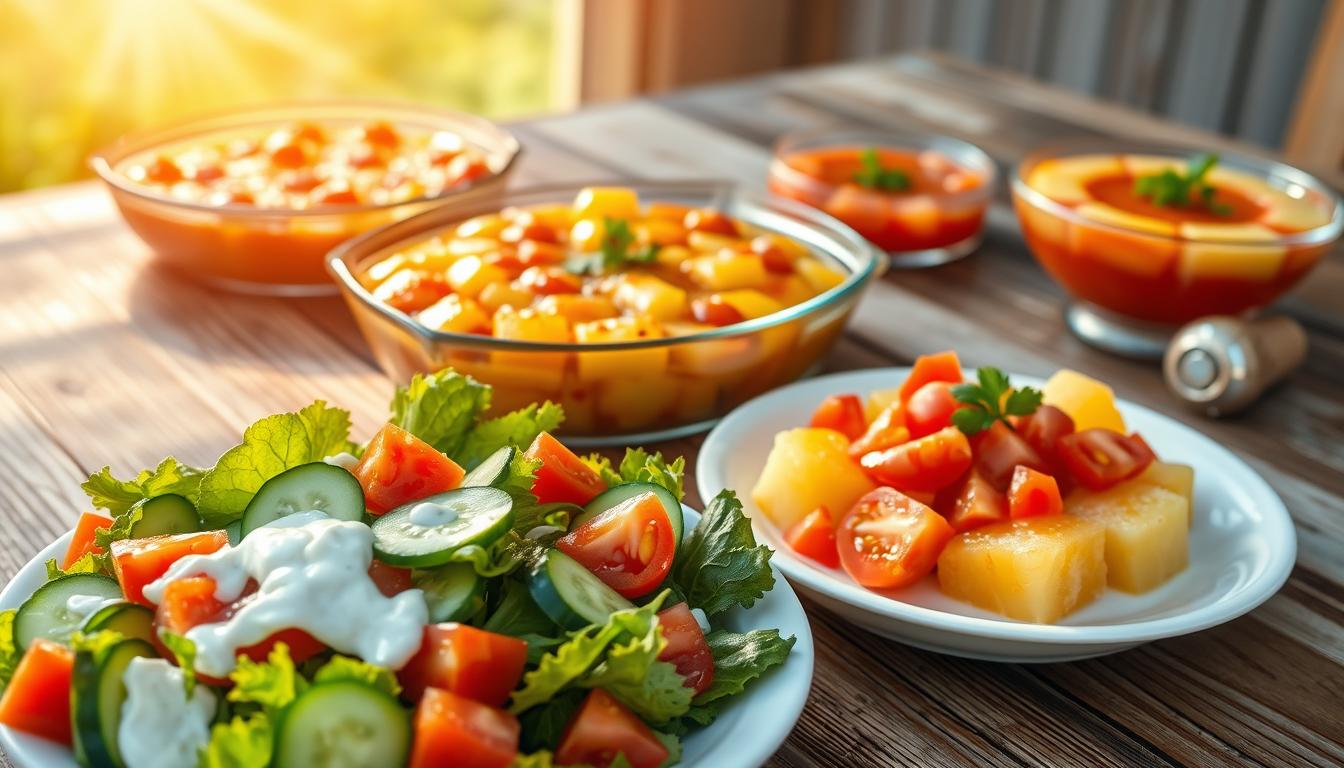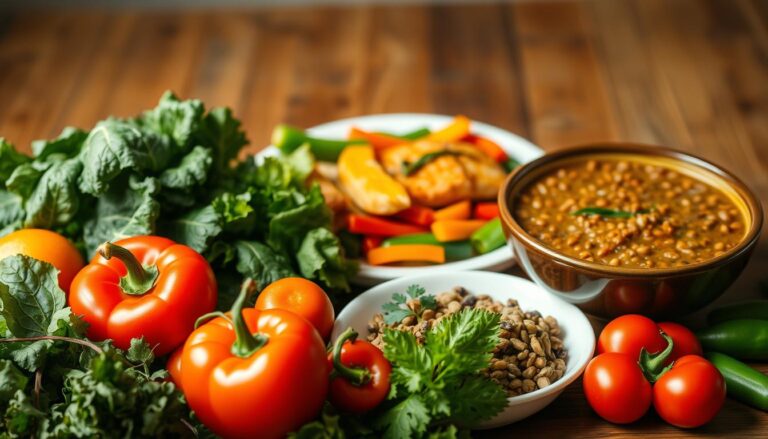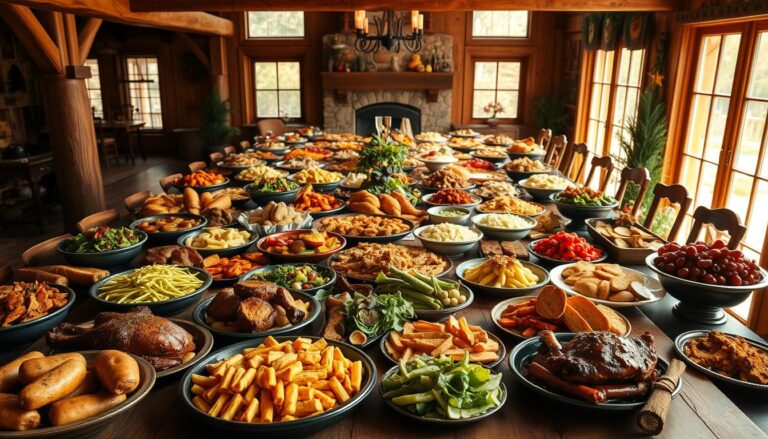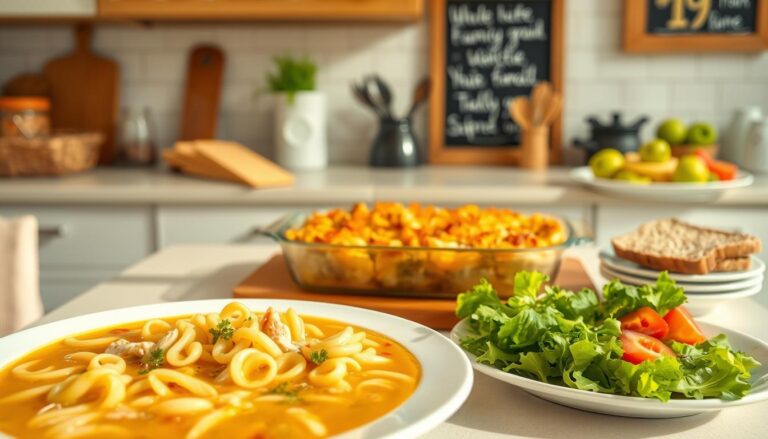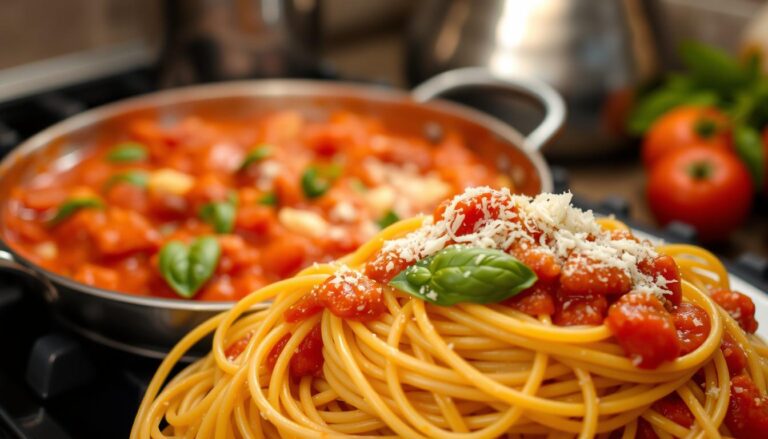Southern Classics: Salads, Pineapple Casserole & Tomato Aspic
The charm of Southern classics lies in their rich heritage and the cultural significance they hold in traditional cuisine. These timeless dishes have been passed down through generations, evoking memories of family gatherings and warm hospitality.
Among the beloved traditional Southern recipes are refreshing salads, sweet pineapple casserole, and savory tomato aspic. These dishes are more than just recipes; they represent the heart of Southern culture.
Exploring these classic dishes provides a glimpse into the history and traditions of the South. From the simplicity of a well-crafted salad to the complexity of a perfectly baked casserole, each dish tells a story.
Key Takeaways
- Discover the rich heritage behind traditional Southern recipes.
- Learn about the cultural significance of Southern classics.
- Explore refreshing Southern salads and their variations.
- Understand the appeal of sweet pineapple casserole.
- Get insights into the savory delight of tomato aspic.
The Rich Heritage of Southern Cuisine
The heritage of Southern cuisine is deeply rooted in its regional diversity and historical context. As Julia Reed once said, “Southern food is not just about eating, it’s about gathering, sharing, and the love that comes with it.” This quote encapsulates the essence of Southern cuisine, which is as much about the food as it is about the culture and community.
Regional Influences on Southern Food Traditions
Southern cuisine has been shaped by various regional influences, including African, European, and Native American cuisines. The use of local ingredients such as sweet potatoes, okra, and peanuts reflects the agricultural heritage of the South. These ingredients have been incorporated into traditional dishes, creating a unique flavor profile that characterizes Southern cooking.
The Evolution of Southern Entertaining
Southern entertaining has evolved significantly over time, from traditional family gatherings to modern-day social events. The art of hosting has been refined, with an emphasis on hospitality and generous portions. As Edna Lewis noted, “The spirit of Southern hospitality is about making others feel at home.” This spirit continues to define Southern entertaining, with a focus on comfort food and warm hospitality.
Traditional Southern Salads: A Culinary Staple
Southern salads are a testament to the region’s culinary creativity, blending local ingredients into refreshing and flavorful dishes. These salads have become an integral part of Southern cuisine, often serving as a centerpiece at family gatherings, potlucks, and social events. The diversity of Southern salads is remarkable, ranging from fruit-based to vegetable-based varieties, each with its unique charm and flavor profile.
Iconic Southern Salad Varieties
Southern cuisine boasts a wide array of iconic salad varieties that have been passed down through generations. These salads are not only delicious but also reflect the cultural and agricultural heritage of the South.
Fruit Salads and Their Significance
Fruit salads are a staple in Southern cuisine, often featuring seasonal fruits such as peaches, berries, and citrus. These salads are not only refreshing but also showcase the South’s rich agricultural bounty. Classic fruit salads are typically made with a mix of fresh fruits, sometimes accompanied by a light syrup or whipped cream.
Vegetable-Based Southern Salads
Vegetable-based salads are equally popular in the South, with ingredients like tomatoes, cucumbers, and beans being common. These salads often highlight the simplicity and freshness of Southern produce. Tomato salad, for instance, is a summer favorite, made with ripe tomatoes, onions, and a light vinaigrette.
Key Ingredients That Define Southern Salads
The essence of Southern salads lies in their use of local and seasonal ingredients. Key ingredients often include fresh vegetables, fruits, and sometimes proteins like chicken or bacon. The use of mayonnaise-based dressings is also characteristic, adding a rich and creamy texture to many Southern salads. Understanding these key ingredients is crucial to appreciating the flavor and cultural significance of Southern salads.
The Beloved Congealed Salad Tradition
In the South, congealed salads are more than just a side dish; they’re a tradition. These gelatin-based dishes have been a staple at Southern gatherings for decades, bringing families and friends together.
Origins of Gelatin-Based Dishes in Southern Cuisine
The tradition of congealed salads in the South dates back to the early 20th century when gelatin became a popular ingredient. These salads were initially made with readily available ingredients like canned fruit and vegetables, making them an economical choice for large gatherings.
Cultural Significance at Southern Gatherings
Congealed salads play a significant role in Southern hospitality, often serving as a centerpiece at various events.
Holiday Table Traditions
During holidays, congealed salads are a common sight on Southern tables, adding a touch of tradition to the meal.
Church Suppers and Family Reunions
At church suppers and family reunions, these salads are a crowd-pleaser, offering a refreshing contrast to the rich, comforting dishes typically served.
The versatility of congealed salads allows them to be adapted to various tastes and dietary preferences, ensuring their continued popularity at Southern gatherings.
Tomato Aspic: A Southern Delicacy
In the realm of Southern cuisine, few dishes evoke the charm of yesteryear quite like tomato aspic. This quintessential delicacy has been a staple at family gatherings and social events for decades, offering a refreshing and tangy complement to various Southern classics.

History and Evolution
The history of tomato aspic is deeply rooted in the tradition of gelatin-based salads that gained popularity in the mid-20th century. As Southern cuisine evolved, incorporating influences from various cultures, tomato aspic emerged as a unique and flavorful dish. Its evolution is closely tied to the availability of ingredients like canned tomatoes and gelatin, making it an accessible yet elegant option for hosts.
Classic Tomato Aspic Recipe
A classic tomato aspic recipe is straightforward, requiring a few essential ingredients and a simple preparation method.
Essential Ingredients
- Canned tomatoes
- Gelatin
- Onion
- Bell pepper
- Celery
- Seasonings
Preparation Method
- Dissolve gelatin in a mixture of boiling water and tomato juice.
- Add chopped vegetables and seasonings.
- Pour into a mold and chill until set.
- Serve chilled, garnished with fresh herbs if desired.
Modern Variations and Adaptations
While the classic recipe remains beloved, modern variations of tomato aspic have introduced new flavors and ingredients. Some adaptations include using fresh tomatoes instead of canned, adding spices for extra flavor, or incorporating other vegetables for added texture. These variations not only keep the dish relevant but also allow it to evolve with changing culinary trends.
Mastering the Perfect Tomato Aspic
Mastering tomato aspic is an art that requires precision, patience, and a deep understanding of its components. To create this Southern delicacy, one must be well-versed in the essential equipment and techniques.
Essential Equipment and Techniques
To start, you’ll need a few key pieces of equipment, including a blender or food processor, a fine-mesh sieve, and a mold to shape your aspic. Proper technique is crucial when preparing the ingredients; for instance, ensuring that the tomatoes are fully pureed and strained is vital for a clear aspic. Additionally, using unflavored gelatin and dissolving it correctly is essential for the aspic to set properly.
Step-by-Step Preparation Guide
Begin by preparing your ingredients: puree cooked tomatoes with their juices, then strain the mixture through a fine-mesh sieve. Dissolve unflavored gelatin in a small amount of cold water, then add it to the tomato mixture along with seasonings. Pour the mixture into a prepared mold and chill until set. The key to a successful aspic lies in its preparation and patience, as it needs time to chill and set.
Troubleshooting Common Issues
Despite careful preparation, issues can arise. Two common problems are cloudy aspic and setting problems.
Fixing Cloudy Aspic
A cloudy aspic can result from inadequate straining of the tomato mixture. To avoid this, ensure that you strain the mixture thoroughly.
Addressing Setting Problems
If your aspic fails to set, it may be due to insufficient gelatin or improper dissolution. Check that you’ve used the correct amount of gelatin and that it was fully dissolved before chilling.
| Issue | Cause | Solution |
|---|---|---|
| Cloudy Aspic | Inadequate straining | Strain tomato mixture thoroughly |
| Setting Problems | Insufficient gelatin or improper dissolution | Use correct amount of gelatin and dissolve properly |
Southern Salads, Pineapple Casserole, and Tomato Aspic: Serving Suggestions
To make your Southern gatherings truly memorable, consider these serving suggestions for your favorite salads, pineapple casserole, and tomato aspic. The key to a successful gathering lies in the details of presentation and accompaniments.
Traditional Accompaniments
When serving Southern classics, traditional accompaniments can enhance their flavors. For salads, consider pairing with warm cornbread or crusty bread. Pineapple casserole goes well with grilled meats or roasted chicken. Tomato aspic is often served with crackers or toast points.
Seasonal Serving Ideas
To add a seasonal touch to your Southern gatherings, consider the time of year and incorporate fresh ingredients. In the spring, add fresh herbs to your salads, while summer gatherings call for light and refreshing sides. For fall and winter, incorporate warm spices and roasted vegetables into your dishes.
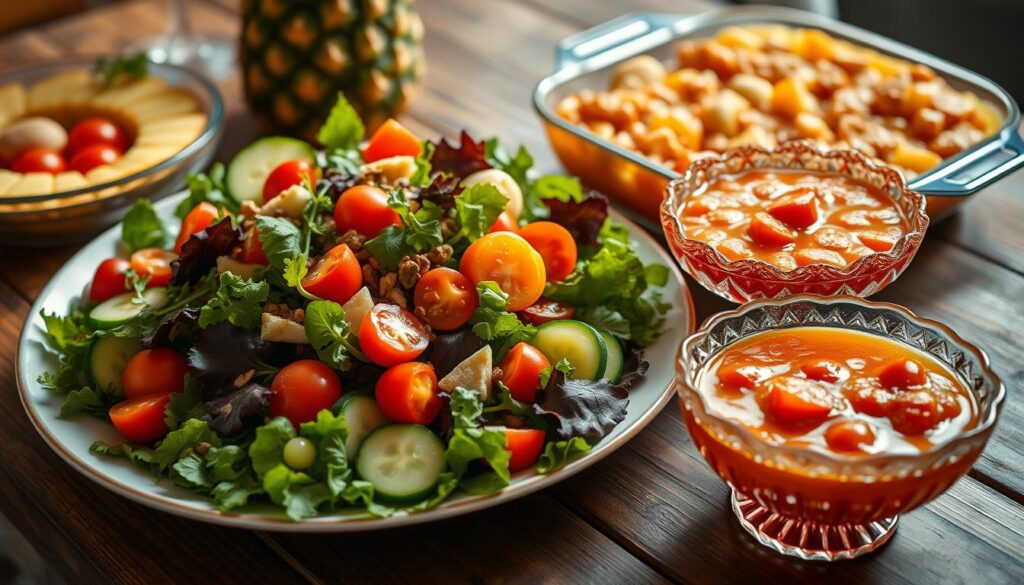
Presentation Tips for Southern Entertaining
Presentation is key when it comes to Southern entertaining. Consider using attractive serving vessels and garnishes to add visual appeal.
Garnishing for Visual Appeal
Garnishing with fresh herbs, edible flowers, or citrus slices can add a pop of color to your dishes. For tomato aspic, consider garnishing with fresh basil or chopped chives.
Serving Vessels and Traditions
The right serving vessels can add to the ambiance of your gathering. Consider using family heirlooms or traditional Southern dishes to serve your salads, pineapple casserole, and tomato aspic.
Pineapple Casserole: The Sweet-Savory Southern Classic
In the heart of Southern cooking lies the pineapple casserole, a dish that masterfully blends the tropical sweetness of pineapple with the richness of cheese and crackers. This beloved side dish has become a staple at Southern gatherings, embodying the warmth and hospitality that defines the region’s cuisine.
Origins and Cultural Significance
Pineapple casserole’s origins are rooted in traditional Southern cuisine, where resourcefulness and creativity in the kitchen were paramount. This dish is a testament to the ingenuity of Southern cooks who could transform simple ingredients into something extraordinary. It has become a cultural icon, symbolizing community and warmth at family gatherings and holiday feasts.
Traditional Pineapple Casserole Recipe
A classic pineapple casserole recipe typically includes canned pineapple, sugar, flour, butter, and a crunchy topping made from crackers and cheese. The preparation involves mixing the pineapple with dry ingredients and then topping it with a layer of crackers and cheese before baking until golden brown.
Ingredient Selection
The choice of ingredients is crucial. Canned pineapple is preferred for its sweetness and convenience. The type of crackers used can vary, but crushed Ritz crackers are a popular choice for their buttery flavor.
Preparation Method
To prepare, mix drained canned pineapple with sugar and flour, then stir in melted butter. The mixture is then poured into a baking dish and topped with a mixture of crushed crackers and shredded cheese. The casserole is baked until the top is golden and the filling is bubbly.
Regional Variations Across the South
While the core ingredients remain the same, regional variations of pineapple casserole exist across the South. Some recipes may include additional ingredients like nuts or spices, reflecting local tastes and preferences. These variations highlight the dish’s versatility and its ability to be adapted to different regional flavors.
Creating the Ultimate Pineapple Casserole
Pineapple casserole, a staple of Southern gatherings, can be elevated to new heights with the right approach. The key to an ultimate pineapple casserole lies in its components and preparation methods.
Cheese Selection and Preparation
The choice of cheese is crucial. A sharp cheddar is often preferred for its robust flavor that complements the sweetness of pineapple. Grating the cheese fresh is recommended for the best results.
Cooking Techniques for Perfect Results
Achieving the perfect pineapple casserole involves balancing cooking techniques. Even heating is essential to prevent the crust from burning before the filling is fully heated through.
Achieving the Ideal Texture
The ideal texture is creamy and smooth, with a crunchy topping. This can be achieved by not overmixing the filling and ensuring the crust is adequately browned.
Balancing Sweet and Savory Flavors
The interplay between sweet and savory flavors is what makes pineapple casserole delightful. Adjusting the amount of sugar and the type of cheese can help achieve this balance.
| Ingredient | Role | Tips |
|---|---|---|
| Pineapple | Provides sweetness and moisture | Drain well to avoid sogginess |
| Cheddar Cheese | Adds savory flavor | Grate fresh for better texture |
| Crust | Provides crunch | Use breadcrumbs or crushed crackers |
Make-Ahead and Storage Tips
Pineapple casserole can be prepared ahead of time. Assemble the dish, cover, and refrigerate overnight. Bake just before serving. Leftovers can be stored in the refrigerator for up to 3 days.
Southern Slaw and Potato Salad Variations
From backyard barbecues to family reunions, Southern slaw and potato salad are the perfect accompaniments to many traditional meals. These dishes are staples in Southern cuisine, offering a variety of flavors and textures that complement a range of main courses.
Classic Coleslaw Recipes from Across the South
Coleslaw is a versatile side dish that can be found in many variations across the South. The primary distinction lies in the dressing, with some regions preferring vinegar-based slaws, while others enjoy creamy variations.
Vinegar-Based vs. Creamy Variations
Vinegar-based slaws are tangy and refreshing, often made with a mixture of apple cider vinegar, sugar, and spices. Creamy slaws, on the other hand, are rich and indulgent, typically featuring mayonnaise as a key ingredient.
Regional Ingredient Differences
Regional ingredients play a significant role in shaping the flavor profiles of coleslaw. For instance, some recipes include shredded cabbage, while others add grated carrots for extra color and sweetness.
Regional Potato Salad Traditions
Potato salad is another beloved side dish in the South, with various regions boasting their own unique recipes. Some common ingredients include boiled potatoes, mayonnaise, and hard-boiled eggs.
| Region | Potato Salad Variation | Key Ingredients |
|---|---|---|
| South Carolina | Mustard-Based | Potatoes, mustard, mayonnaise |
| Texas | Spicy | Potatoes, jalapeños, sour cream |
| Georgia | Classic Southern | Potatoes, mayonnaise, relish |
Modern Twists on Traditional Recipes
While traditional recipes remain popular, modern twists can add exciting new flavors to these classic dishes. Examples include adding Greek yogurt to coleslaw for a healthier alternative or incorporating roasted garlic into potato salad for a deeper flavor.
Health-Conscious Adaptations of Southern Classics
The South’s beloved dishes are being adapted for the health-conscious, offering a fresh take on traditional cuisine. As people become more aware of their dietary choices, Southern classics are being reimagined with healthier ingredients without sacrificing their signature flavors.
Lightened-Up Versions of Traditional Recipes
One approach to health-conscious adaptations is reducing sugar and fat content in traditional recipes. For instance, using natural sweeteners like honey or maple syrup instead of refined sugar can significantly cut down on calorie intake.
Reducing Sugar and Fat Content
By substituting high-fat ingredients with lower-fat alternatives, such as using Greek yogurt instead of mayonnaise, dishes can be made healthier. Additionally, reducing the amount of sugar in desserts or using fruit purees can achieve the desired sweetness without excessive sugar.
Ingredient Substitutions
Ingredient substitutions play a crucial role in creating healthier versions of Southern classics. For example, using cauliflower rice instead of traditional rice or opting for baked sweet potato fries instead of regular fries.
Dietary Modifications Without Sacrificing Flavor
Dietary modifications can be made without compromising on flavor. Using herbs and spices to enhance flavor instead of salt and sugar is a effective strategy. For example, adding fresh basil to tomato aspic or using smoked paprika in pineapple casserole.
| Traditional Ingredient | Healthier Alternative |
|---|---|
| Mayonnaise | Greek Yogurt |
| Refined Sugar | Honey or Maple Syrup |
| Regular Fries | Baked Sweet Potato Fries |
Conclusion: Preserving Southern Culinary Traditions
Southern cuisine is a rich tapestry of flavors and traditions that have been passed down through generations. The classic Southern dishes, such as salads, pineapple casserole, and tomato aspic, play a significant role in shaping the region’s cultural identity.
Preserving Southern traditions is crucial to maintaining the heritage of the South. By continuing to prepare and share these classic dishes, we honor the culinary legacy of our ancestors and keep the spirit of Southern hospitality alive.
The Southern culinary heritage is characterized by its use of local ingredients, creative adaptations, and warm hospitality. As we move forward, it’s essential to balance tradition with innovation, ensuring that these beloved dishes remain relevant and enjoyable for future generations.
By embracing and preserving classic Southern dishes, we not only celebrate the region’s history but also foster a sense of community and connection. Whether you’re a native Southerner or just a fan of the cuisine, these timeless recipes are sure to bring people together and create lasting memories.

